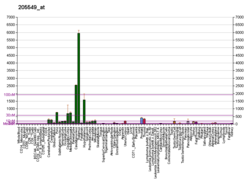Protein-coding gene in the species Homo sapiens
| PCP4 |
|---|
|
| Identifiers |
|---|
| Aliases | PCP4, PEP-19, Purkinje cell protein 4 |
|---|
| External IDs | OMIM: 601629; MGI: 97509; HomoloGene: 4519; GeneCards: PCP4; OMA:PCP4 - orthologs |
|---|
| Gene location (Human) |
|---|
 | | Chr. | Chromosome 21 (human)[1] |
|---|
| | Band | 21q22.2 | Start | 39,867,438 bp[1] |
|---|
| End | 39,929,397 bp[1] |
|---|
|
| Gene location (Mouse) |
|---|
 | | Chr. | Chromosome 16 (mouse)[2] |
|---|
| | Band | 16 C4|16 56.97 cM | Start | 96,268,806 bp[2] |
|---|
| End | 96,326,993 bp[2] |
|---|
|
| RNA expression pattern |
|---|
| Bgee | | Human | Mouse (ortholog) |
|---|
| Top expressed in | - lateral nuclear group of thalamus
- external globus pallidus
- middle frontal gyrus
- Epithelium of choroid plexus
- putamen
- caudate nucleus
- nucleus accumbens
- seminal vesicula
- retinal pigment epithelium
- internal globus pallidus
|
| | Top expressed in | - striatum of neuraxis
- olfactory bulb
- cerebellum
- layer of retina
- neural layer of retina
- cerebellar cortex
- superior frontal gyrus
- dentate gyrus of hippocampal formation granule cell
- urinary bladder
- primary visual cortex
|
| | More reference expression data |
|
|---|
| BioGPS |  | | More reference expression data |
|
|---|
|
| Gene ontology |
|---|
| Molecular function | - protein binding
- calcium ion binding
- calmodulin binding
| | Cellular component | - cytosol
- nucleus
- protein-containing complex
| | Biological process | - positive regulation of neuron differentiation
- calmodulin dependent kinase signaling pathway
| | Sources:Amigo / QuickGO |
|
| Orthologs |
|---|
| Species | Human | Mouse |
|---|
| Entrez | | |
|---|
| Ensembl | | |
|---|
| UniProt | | |
|---|
| RefSeq (mRNA) | | |
|---|
| RefSeq (protein) | | |
|---|
| Location (UCSC) | Chr 21: 39.87 – 39.93 Mb | Chr 16: 96.27 – 96.33 Mb |
|---|
| PubMed search | [3] | [4] |
|---|
|
| Wikidata |
| View/Edit Human | View/Edit Mouse |
|
Purkinje cell protein 4 is a protein that in humans is encoded by the PCP4 gene.[5][6][7] Also known as PEP-19, PCP4 is a 7.6 kDa protein with an IQ-motif that binds to calmodulin (CaM).[8] PCP4 is abundant in Purkinje cells of the cerebellum, and plays an important role in synaptic plasticity.[8][9]
Function
PCP4 knockout mice have been reported to exhibit impaired locomotor learning and markedly altered synaptic plasticity in cerebellar Purkinje neurons.[8] PCP4 accelerates both the association and dissociation of calcium (Ca2+) with calmodulin (CaM), which is postulated to influence the activity of CaM-dependent enzymes, especially CaM kinase II (CaMK-II).[8][10][11]
References
- ^ a b c GRCh38: Ensembl release 89: ENSG00000183036 – Ensembl, May 2017
- ^ a b c GRCm38: Ensembl release 89: ENSMUSG00000090223 – Ensembl, May 2017
- ^ "Human PubMed Reference:". National Center for Biotechnology Information, U.S. National Library of Medicine.
- ^ "Mouse PubMed Reference:". National Center for Biotechnology Information, U.S. National Library of Medicine.
- ^ Chen H, Bouras C, Antonarakis SE (Jan 1997). "Cloning of the cDNA for a human homolog of the rat PEP-19 gene and mapping to chromosome 21q22.2-q22.3". Hum Genet. 98 (6): 672–7. doi:10.1007/s004390050282. PMID 8931698. S2CID 19837689.
- ^ Cabin DE, Gardiner K, Reeves RH (Dec 1996). "Molecular genetic characterization and comparative mapping of the human PCP4 gene". Somat Cell Mol Genet. 22 (3): 167–75. doi:10.1007/BF02369907. PMID 8914602. S2CID 41800640.
- ^ "Entrez Gene: PCP4 Purkinje cell protein 4".
- ^ a b c d Wei P, Blundon JA, Rong Y, Zakharenko SS, Morgan JI (2011). "Impaired locomotor learning and altered cerebellar synaptic plasticity in pep-19/PCP4-null mice". Mol. Cell. Biol. 31 (14): 2838–44. doi:10.1128/MCB.05208-11. PMC 3133400. PMID 21576365.
- ^ Sangameswaran L, Hempstead J, Morgan JI (1989). "Molecular cloning of a neuron-specific transcript and its regulation during normal and aberrant cerebellar development". Proc. Natl. Acad. Sci. U.S.A. 86 (14): 5651–5. Bibcode:1989PNAS...86.5651S. doi:10.1073/pnas.86.14.5651. PMC 297682. PMID 2748608.
- ^ Putkey JA, Kleerekoper Q, Gaertner TR, Waxham MN (2004). "A new role for IQ motif proteins in regulating calmodulin function". J. Biol. Chem. 278 (50): 49667–70. doi:10.1074/jbc.C300372200. PMID 14551202.
- ^ Kleerekoper QK, Putkey JA (2009). "PEP-19, an intrinsically disordered regulator of calmodulin signaling". J. Biol. Chem. 284 (12): 7455–64. doi:10.1074/jbc.M808067200. PMC 2658041. PMID 19106096.
Further reading
- Hubert RS, Korenberg JR (1997). "PCP4 maps between D21S345 and P31P10SP6 on chromosome 21q22.2→q22.3". Cytogenet. Cell Genet. 78 (1): 44–5. doi:10.1159/000134623. PMID 9345904.
- Utal AK, Stopka AL, Roy M, Coleman PD (1998). "PEP-19 immunohistochemistry defines the basal ganglia and associated structures in the adult human brain, and is dramatically reduced in Huntington's disease". Neuroscience. 86 (4): 1055–63. doi:10.1016/S0306-4522(98)00130-4. PMID 9697113. S2CID 13251786.
- Hu YH, Warnatz HJ, Vanhecke D, Wagner F, Fiebitz A, Thamm S, Kahlem P, Lehrach H, Yaspo ML, Janitz M (2006). "Cell array-based intracellular localization screening reveals novel functional features of human chromosome 21 proteins". BMC Genomics. 7: 155. doi:10.1186/1471-2164-7-155. PMC 1526728. PMID 16780588.


















